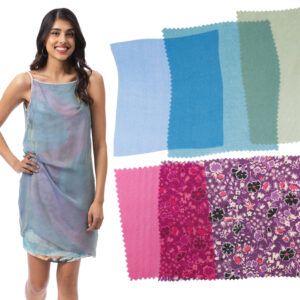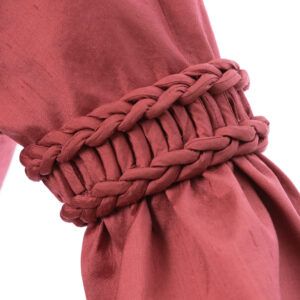*
Dear folks – I just read this story from the NPR story project. I thought it would resonate for the folks who hang out here.- You can also go to www.npr.org and go to the story project and this story is in the archives.
Sarah
National Story Project
With Paul Auster
Listen to the program
May 2001 — Paul Auster reads a story from Donna Bronner of
Santa Teresa, New Mexico.
Sewing Lessons
I had my first sewing lessons as a young child, sitting on the floor
and stitching scraps of fabric into tenuous little creations. Above
me, at the dining room table, my mother made the sewing
machine fly. Every now and then, she would interrupt her sewing
to snip me apart from the thing to which I’d sewn myself, or to
show me how to spit on one thread tail and slip in back through
the needle’s eye. My child stiches resembled Morse code
meandering across the fabric.
Along with my mother’s lessons came her stories — about how her
mother could cut a man’s suit pattern from a newspaper, and
how, during the Depression, her own dresses were fashioned
from flour sacks. I heard about a childhood filled with loss, about
war, day-to-day survival, and my own birth. These stories were as
natural as breathing, and I inhaled them the same way I inhaled
the air.
By suppertime, finished or not, our sewing was put away to make
room for a meal and the intrusions of family business. Next
morning, out came the machine again and our projects continued.
My official sewing lessons began in a seventh grade home
economics class. A semester of sewing and a semester of cooking
were required to prepare girls for their future roles as wives and
mothers. I was eager to begin my first challenge of early
adolescence.
My teacher, Mrs. Kelso, was a plain, stern woman with brown curls
arranged tightly around her head. I was sure she had no
imagination, since she wore only two-piece suits she had sewn
from equally plain material. “Classic,” she called them.
The sewing technique Mrs. Kelso struggled to impress upon our
prepubescent sensibilities had little in common with my mother’s.
Mom would spread fabric on the floor, lay out a pattern (if she had
one), stick in some pins, cut and sew. And a short time later, I
would have a new dress.
Mrs. Kelso was by the book. Our first project — a passage rite, it
seemed — was to sew snaps onto little squares of fabric. Each
time we pulled the thread through the hole on the snap, we made
a knot, pushing it close to the edge of the fastener with a thumb
nail. My dingy knots didn’t line up around the snap, so I had to
repeat the exercise two more times. When I showed my mother
what I’d learned, her response was, “Phooey, who’s got time for
that?”
Technique aside, the greatest difference between my two
teachers was their philosophy of work. My mother whistled and
clapped her hands. We sang Sixteen Tons with Tennessee Ernie
Ford and marched in circles to a worn recording of The Gollywog’s
Cakewalk. One of the rare times I saw my mother weep was to a
recording of Gypsy violin music as she adjusted gathers on the
bodice of my dress.
To Mrs. Kelso, sewing was a science — something you went to
college to learn. She didn’t allow singing, not even a radio. When
my class was finally judged fit for real sewing, Mrs. Kelso picked a
foolproof A-line, V-neck jumper: no buttons, zippers, darts or
pizzazz. My mother helped me choose a lovely gray flannel for my
jumper. I could hardly wait to cut into it.
Before we were allowed to remove fabric from the sack, Mrs. Kelso
made us read the entire pattern instruction sheet and tested us
on pattern terms. Finally, we spread our fabric on big tables,
pinned the pattern pieces exactly as the layout instructions
showed and cut along the solid lines, making little triangle
bump-outs at the notches. (My mother never bothered with
notches.) Mrs. Kelso made us hem the jumper to a length below
our knees. The horrible outcome of this effort was evident in the
mirror: I resembled a skinny chicken in a flour-sack dress. I don’t
remember my grade.
I brought my jumper home, vowing never to wear it. My mother
salvaged the outfit by raising the hem to 1965 standards,
adjusting the side seams to fit my slim body, and buying a pink
crepe blouse with long ties that wrapped into a bow under my
chin.
By the end of the semester with Mrs. Kelso, I didn’t want to be a
wife or mother. But, by the time I was 21, I was both and I didn’t
have time for most of what Mrs. Kelso had taught me. But my
mother’s lessons helped me to work quickly through each project.
I learned to match my effort to the amount of baby spit-up that



























Replies
*
oh, sarah. this is a wonderful story. thank you for posting it. it reminds me of my sewing at age 5 with my grandmother (i would also sit on the floor while she zoomed at the machine).
I just sent it to my mom.
*I really enjoyed that story. My Mom died two years ago. She was an avid sewer and could make anything. While going through some of her things recently, I found a book entitled "Teaching your Daughter how to Sew". It reminded me of just how much she wanted me to share sewing with her.
This post is archived.